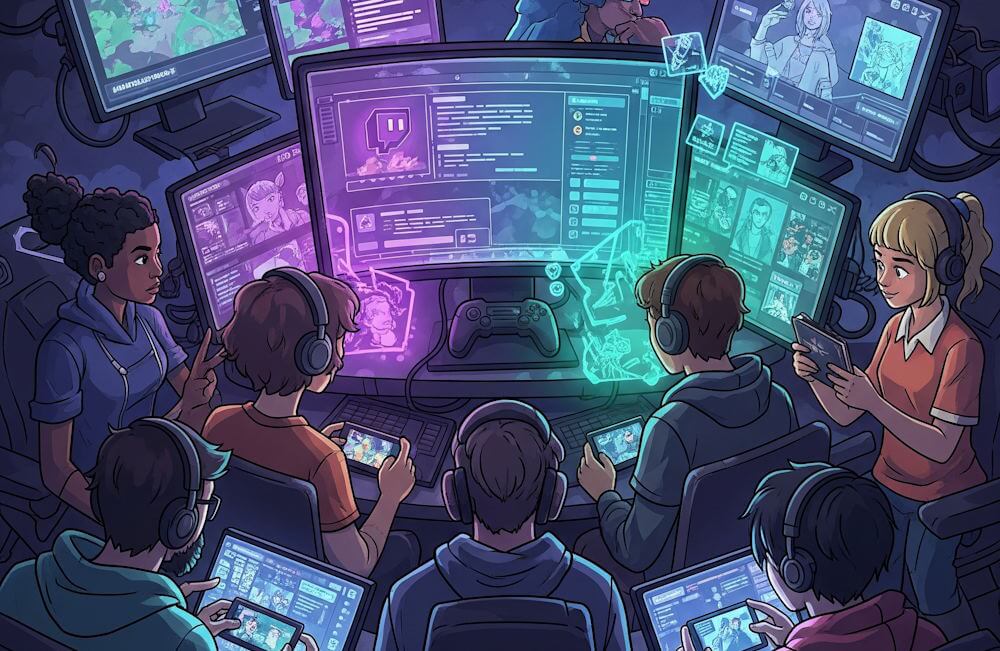Gaming fandoms refer to the various communities that form around specific games, genres, or gaming cultures. These fandoms exhibit distinct characteristics that contribute significantly to the overall gaming experience. Members often share a deep appreciation for the game mechanics, storylines, and character development, which fosters a sense of belonging. At the heart of these communities lies a passion for gaming that transcends casual interest, cultivating dedicated groups of players ranging from casual gamers to highly competitive individuals.
Casual players typically engage with games for enjoyment and relaxation, often participating less frequently but expressing their interest through social interactions and local gaming events. Competitive gamers, on the other hand, take their engagement a step further by investing time in mastering gameplay mechanics, competing in tournaments, and following esports. This dedication demonstrates the significance of skill and strategy within a recognized community, where players strive for excellence and recognition.
In addition to casual and competitive players, dedicated fans exhibit an even deeper involvement with the games they love. These individuals may create fan art, write fan fiction, or develop mods, contributing to the rich tapestry of content within gaming fandoms. By sharing their enthusiasm on platforms like Twitch and YouTube, they not only enhance their own engagement but also promote the games to a wider audience. Their collective efforts help sustain the vibrancy of the gaming community, encouraging developers to pay attention to player feedback and trends.
Ultimately, gaming fandoms serve as a vital conduit for communication and collaboration among gamers, shaping the games of tomorrow. As members connect through shared experiences, they help build supportive environments, creating a sense of community that drives both the popularity and evolution of gaming. This interplay between fandoms and game development is critical for creating immersive experiences that resonate with players worldwide.
Historical Evolution of Gaming Fandoms
The evolution of gaming fandoms has been influenced by technological advancements, cultural shifts, and the growing accessibility of video games. In the late 1970s and early 1980s, as arcades flourished and home consoles emerged, gaming began to attract a dedicated audience. Early fandoms often emerged within localized communities, where players gathered to share experiences and tips. Notably, the launch of titles like “Space Invaders” and the Atari 2600 marked significant milestones, sparking the initial wave of enthusiasm that contributed to the formation of nascent fandoms.
As gaming technology progressed through the late 1980s and 1990s, the dawn of the internet allowed fandoms to expand beyond physical gatherings. Online forums and bulletin boards became crucial platforms for gamers, enabling discussions and the sharing of strategies, fan art, and modifications. This period witnessed the rise of dedicated fan sites for franchises such as “Final Fantasy,” “The Legend of Zelda,” and “Super Mario,” which helped solidify communities and foster deep connections among fans. The introduction of fan conventions, including events such as the Electronic Entertainment Expo (E3) and Comic-Con, gave fans opportunities to celebrate their beloved franchises in person.
The 2000s saw a further evolution of gaming fandoms with the advent of social media platforms like Facebook, Twitter, and later, Discord. These platforms exponentially increased the reach and dynamic nature of fandom interactions, allowing instant communication and real-time updates from developers. Major game releases, such as “World of Warcraft” and various iterations of the “Call of Duty” franchise, further expanded the fanbase, demonstrating the power of community in shaping discourse around game development. Fandoms became instrumental in influencing game design and marketing strategies, showcasing their integral role in the gaming industry’s landscape today.
The Role of Fandoms in Game Development
Gaming fandoms play an essential role in the evolution of video game development, serving not only as a vibrant community of enthusiasts but also as crucial stakeholders in the creative process. Developers have increasingly recognized that engaging with fans can lead to enhanced game experiences and stronger brand loyalty. One of the most significant ways in which fandoms influence game development is through feedback loops. Developers often solicit input from dedicated players regarding gameplay mechanics, character designs, and narrative elements. This interactive relationship helps designers create games that resonate better with their target audiences.
Beta testing programs are another avenue through which developers involve fans. By allowing selected players access to unfinished versions of games, developers can gather valuable insights about gameplay and potential bugs. This preparatory stage helps refine the final product by ensuring that fan expectations are met, thus elevating the overall quality of the game. Feedback collected during these beta tests can lead to important adjustments, ranging from minor tweaks to fundamental changes that reshape the gaming experience.
Community events, such as conventions and online forums, further exemplify the collaboration between developers and fans. These gatherings provide platforms where developers can showcase upcoming features while directly interacting with their audience. This direct engagement allows fans to vocalize their preferences and expectations for new releases, which can significantly influence the direction of ongoing projects. Successful examples abound, with some developers publicly crediting fan-generated ideas and inputs for pivotal transformations in their game series.
By integrating fan input into the development workflow, gaming companies can create immersive experiences that not only attract new players but also foster a sense of ownership among long-standing fans. This collaborative dynamic exemplifies the growing trend of co-creation in the realm of digital entertainment. Ultimately, the symbiosis between gaming fandoms and developers enhances the industry and enriches the lives of players worldwide.
Case Studies of Impactful Fandoms
The influence of gaming fandoms on the industry is well-illustrated through several significant case studies, particularly involving franchises such as ‘The Legend of Zelda’, ‘Final Fantasy’, and ‘Overwatch’. Each of these fandoms not only demonstrates strong community engagement but also showcases how fan interaction can shape game development, marketing strategies, and the longevity of a franchise.
Consider ‘The Legend of Zelda’, a franchise that has cultivated a passionate fanbase since its inception in 1986. Fans have actively participated in discussions, crafting extensive fan theories and art that enrich the game’s lore. The feedback from this community has often been integrated into subsequent game developments, as seen in the design choices for ‘Breath of the Wild’, which emphasized open-world exploration, a concept heavily echoed in fan discussions preceding its release.
Similarly, the ‘Final Fantasy’ series exhibits the profound impact of its loyal fandom. The series has seen fans hold conventions, engage in online forums, and even create fan-made content that provides feedback and showcases future possibilities for the franchise. These interactions have directly influenced elements such as in-game mechanics and character development seen in titles like ‘Final Fantasy XV’, where fans’ desires for character depth and narrative complexity were addressed, indicating a responsive approach from developers.
Then, there is ‘Overwatch’, a newer yet highly influential game that has mobilized its community through events such as the Overwatch League and numerous fan art competitions. The active involvement of fans drives developers to implement updates in response to community sentiment. For example, character balance changes often arise from the vocal discussions surrounding gameplay experiences within the fandom, highlighting how community feedback can lead to immediate practical outcomes in game balancing.
These case studies exemplify how the passion of gaming fandoms can lead to significant impacts in various facets of game development. Their unwavering engagement not only shapes titles already loved but also paves the way for future innovations within the gaming landscape.
The Dark Side of Fandoms: Toxicity and Backlash
Fandoms can be a powerful source of support and creativity, yet they are not without their darker elements. One of the prevalent issues in gaming fandoms is toxicity, which can manifest in various harmful behaviors including harassment, entitlement, and gatekeeping. These negative aspects have profound implications not only for game developers but also for community members who participate in these cultures.
Fan entitlement is particularly concerning, as it can lead to unrealistic expectations regarding game development. Instances such as backlash against developers for perceived failures—be it a game not meeting specific fan expectations or changes in a beloved franchise—illustrate this phenomenon. A notable example includes the backlash faced by the developers of a popular RPG following a controversial story decision. This led to significant online harassment, which impacted both team morale and public perception of the game. Such backlash creates an environment where developers may feel pressured to prioritize fan demands over creative vision, stifling innovation.
Another issue is gatekeeping, where certain segments of fandoms impose arbitrary standards on who is considered a “true fan.” Such behavior can alienate newcomers, creating a toxic atmosphere that discourages engagement. This is detrimental not only to the community but to the gaming industry as a whole, as diverse perspectives and contributions can be lost. The consequences of these behaviors extend further, affecting mental health and well-being within the community. Those targeted often experience emotional distress that can diminish their enjoyment of gaming as a hobby.
To address these problems, it is crucial for both developers and community leaders to actively promote inclusivity and respect within fandoms. Initiatives aimed at fostering healthy dialogues and encouraging constructive criticism over personal attacks can help mitigate the negative impacts of toxicity. Ultimately, by recognizing and combating these harmful behaviors, the gaming community can evolve into a more positive and supportive environment.
The Future of Game Development in Light of Fandoms
The realm of game development is evolving rapidly, significantly influenced by the dynamics of fandoms. As developers increasingly recognize the impact of dedicated gaming communities, they are transitioning from traditional development approaches to more fan-centered strategies. This shift not only enhances the gaming experience but also fosters a closer relationship between creators and their audience. One key element in this evolution is the rising expectation for accountability and transparency among developers. Fandoms today demand more than just high-quality games; they seek a participatory role in the development process, prompting studios to be more communicative about their choices and decisions.
Moreover, the rise of user-generated content (UGC) is reshaping the gaming landscape. As tools for creating and sharing content become more sophisticated and accessible, fans are empowered to contribute significantly to their favorite titles. This collaborative environment encourages developers to embrace fan creations, which frequently leads to an enriched gaming universe. By incorporating community-driven innovations, studios not only expand their game offerings but also cultivate a sense of ownership among fans, driving loyalty and sustained engagement.
Looking ahead, advancements in technology, such as virtual reality (VR) and augmented reality (AR), are likely to further enhance the integration of fandom dynamics within game development. These platforms allow for immersive experiences where fan communities can interact and share experiences in unprecedented ways. Consequently, developers will have to remain agile, adapting to new fan expectations while innovating their offerings. Additionally, the influence of key figures within influencer culture can propel the popularity of certain games as they bridge the gap between developers and the wider audience. Thus, the future of game development will undeniably be shaped by fandoms, making it critical for developers to remain attuned to their communities’ evolving needs and desires.
Cultivating Healthy Fandom Communities
In gaming, fan communities serve as vibrant ecosystems that can significantly influence game development. Cultivating healthy fandom communities is essential for fostering an inclusive and respectful environment. One of the primary strategies for ensuring positive interactions within these fanbases is the establishment of clear community guidelines. These guidelines should advocate for respect and inclusivity, encouraging members to share their thoughts and perspectives in a constructive manner, thereby nurturing a welcoming atmosphere.
The role of community managers is paramount in this context. They act as mediators, proactively engaging with fans to facilitate discussions, address conflicts, and provide guidance on acceptable conduct. By promoting transparency and open dialogue, community managers can help to create a culture of respect and understanding. Additionally, implementing moderated platforms can help maintain a healthy tone within discussions. Moderation should involve a combination of automated tools and human oversight, ensuring that harmful behaviors are swiftly addressed while encouraging positive interactions.
To foster an inclusive space, it is crucial to actively engage underrepresented voices within the gaming community. Initiatives such as spotlight features on diverse gaming experiences or collaboration with marginalized content creators can not only amplify different perspectives but also reinforce community solidarity. Developers can create environments that encourage healthy fan engagement by hosting regular community events, such as Q&A sessions and feedback forums. These initiatives allow fans to feel valued and recognized, while also providing developers with direct insight into community desires and concerns.
Ultimately, the cultivation of healthy fandom communities requires intentional efforts from both fans and developers alike. By promoting inclusivity, creating moderated spaces, and engaging diverse voices, gaming fandoms can thrive, ultimately shaping the future of game development in positive and impactful ways.
The Intersection of Technology and Fandom
The advent of technology has had a profound impact on the gaming landscape, not just in terms of game development, but also in shaping the interactions within gaming fandoms. Streaming platforms such as Twitch and YouTube Gaming have revolutionized how fans engage with their favorite games and creators. These platforms provide an interactive space where gamers can watch live gameplay, participate in discussions, and even influence game narratives through community votes and polls. The immersive experience offered by these platforms fosters a sense of belonging and community among fans, further solidifying their commitment to the gaming culture.
Social media also plays a critical role in the evolution of gaming fandoms. Platforms like Twitter, Instagram, and Discord have become essential tools for fans to connect, share content, and voice opinions. The immediacy of social media allows fans to engage with developers directly, offering feedback and suggestions that can influence future game updates or entirely new projects. In many cases, developers actively monitor these platforms, demonstrating a willingness to consider fan input, which fosters a collaborative spirit that enhances the overall experience for both sides.
Moreover, emerging technologies such as augmented reality (AR) and artificial intelligence (AI) are beginning to transform the dynamics of gaming fandoms. AR can be employed to create immersive experiences that blend the physical and digital worlds, allowing fans to interact with game elements in unprecedented ways. For example, augmented reality games have enabled fans to engage with the content in their own environments, enhancing community interaction through shared experiences. Meanwhile, AI is increasingly being used to analyze fan behavior and preferences, enabling tailored experiences that cater to the unique interests of individual players or groups. This combination of technology and fan engagement not only advances game development but also enriches the overall gaming culture, making fandoms more vibrant and dynamic than ever before.
Conclusion: The Symbiotic Relationship Between Fandoms and Developers
The intricate relationship between gaming fandoms and developers has become increasingly significant in shaping the future of the gaming industry. As illustrated in the preceding sections, fans possess a unique understanding of game mechanics, narratives, and character development, allowing them to provide invaluable feedback. This collaborative dynamic enhances the creative process, leading to innovations that both satisfy fan demands and push the boundaries of game design.
Developers benefit from tapping into the insights and emotions expressed by their communities. By actively engaging with game enthusiasts, developers can better gauge the features and experiences that resonate most with their audience. The feedback loop created in this partnership enables developers to refine existing games and create new titles that are thoughtfully tailored to the preferences of their fanbase. As fandoms gather around beloved franchises, their collective energy not only fuels excitement for upcoming releases but also solidifies a loyal customer base.
Furthermore, recognizing fandoms as partners in the creative journey fosters a sense of trust and collaboration. When developers acknowledge the contributions of their fans, it fosters a more inclusive atmosphere that encourages open dialogue. Developers who embrace this reciprocal relationship can better achieve the delicate balance between artistic vision and audience expectation. Consequently, the result is often a richer gaming experience that captivates players while highlighting the crucial role of fandoms in the development process.
In conclusion, the symbiotic relationship between gaming fandoms and developers is essential for advancing the industry. By valuing the insights and creativity of fans, developers can create games that not only meet commercial targets but also resonate deeply with players, ultimately cultivating enduring loyalty and engagement with their franchises.



